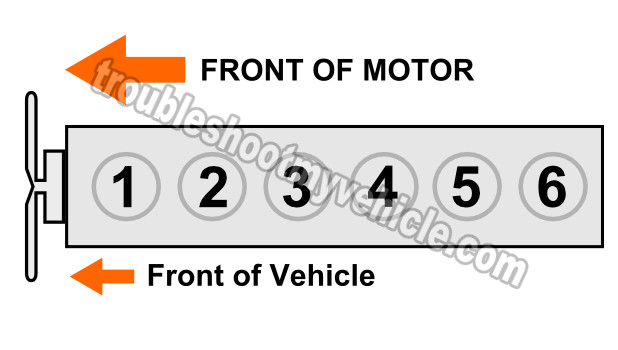
A manual cylinder balance test will help you find out which cylinder is the one that's misfiring on your 4.0L Jeep (this is particularly true if your Jeep is OBD I equipped).
What makes doing a cylinder balance test so easy on the 4.0L equipped Jeeps (whether it has a distributor type ignition system or a coil-on-plug ignition system) is the fact that the fuel injectors are easily accessible.
Contents of this tutorial:
![]() You can find this tutorial in Spanish here: Cómo Hacer Una Prueba Balance De Cilindros (4.0L Jeep) (at: autotecnico-online.com).
You can find this tutorial in Spanish here: Cómo Hacer Una Prueba Balance De Cilindros (4.0L Jeep) (at: autotecnico-online.com).
Finding The Dead Cylinder With A Cylinder Balance Test

In a nutshell, what the manual cylinder balance test involves is disconnecting and reconnecting one fuel injector at a time while the engine is running.
If the engine cylinder is ‘dead’ to begin with, then unplugging its fuel injector from its harness connector will have no effect on the engine's idle.
But if the cylinder is OK and producing power, then unplugging its fuel injector from its harness connector will make the engine idle rougher since you're killing the cylinder.
To get a more accurate test result, what I do is connect a vacuum gauge to a vacuum hose (on the engine) that has vacuum (when the engine is running) with a plastic T. As I disconnect and reconnect each fuel injector, I can see if the vacuum gauge's needle reacts or not. Now, this step is not necessary/critical, so if you don't have a vacuum gauge or can't get a hold of one, you don't need to worry about it.
OK, this is what you need to do:
- 1
Connect your vacuum gauge.
- You can use a plastic ‘T’ connector to connect your vacuum gauge to the fuel pressure regulator's vacuum supply hose.
- NOTE: Remember, using a vacuum gauge is not an absolute must.
- 2
Crank and start the engine.
- NOTE: Take all necessary safety precautions while working around a running engine.
- 3
Disconnect and reconnect one fuel injector at a time.
- When you disconnect the fuel injector, you should hear and feel a drop in the engine's idle (RPMs).
- If you also have a vacuum gauge connected, you'll see the gauge's needle drop.
- If the cylinder was ‘dead’ to begin with for any reason (not getting spark, low compression, etc.), you won't hear/feel a drop in the engine's idle (RPMs).
- 4
Repeat the test on the same cylinder.
- You can repeat this test as many times as you need to make sure of your test result.
- 5
Reconnect the fuel injector and test the next one.
- Perform the test on all of the 6 fuel injectors.
Let's take a look at what your test results mean:
CASE 1: Unplugging the fuel injector caused a drop in the RPMs. This tells you that the specific cylinder you tested is OK and not the cause of the misfire (miss or ‘dead’ condition).
More specifically, this test result lets you know that the fuel injector, spark plug, spark plug wire are OK for that specific cylinder.
CASE 2: Unplugging the fuel injector DID NOT cause a drop in the RPMs. This test result tells you that the specific cylinder you tested is ‘dead’.
The cylinder could be ‘dead’ for a number of reasons. For example:
- Bad spark plug (broken, severely worn out, carbon tracks, etc.).
- Bad spark plug wire.
- Bad distributor cap.
- Low engine compression.
- Bad fuel injector.
Don't let this big list of ‘possibles’ worry you, because one of the most important things you've accomplished with the cylinder balance test, is to find out which cylinder is the ‘dead’ one and this narrows down and focuses your troubleshooting efforts.
You'll find a list of articles that will further help you track down the problem that's causing that specific cylinder to misfire here: Misfire Troubleshooting: The Tutorials.
NOTE: Every now and then, I've seen cases where the engine has a rough idle condition and I mean it's shaking all over the place. When I've done the cylinder balance test, unplugging each fuel injector did not cause any change/drop in the RPMs. Why? This is because whatever is causing the rough idle or miss is affecting all cylinders evenly.
Although it's beyond the scope of this article to test such a condition, I can tell you that the most likely culprit behind this type of problem is usually a leaking intake manifold gasket causing the air/fuel mixture to lean out. Among other things:
- Fuel pressure regulator is leaking fuel into its vacuum hose/line.
- EGR valve stuck open (if the applicable).
- Fuel pump that's outputting insufficient fuel volume/pressure.
- Major vacuum leak.
- Low engine compression across all cylinders.
